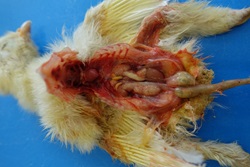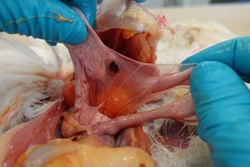- Home
- Disease control
- Animal-diseases
- Infectious-Bronchitis
Infectious Bronchitis
| Robert Jan Molenaar is a poultry veterinarian, pathologist and expert in the field of Infectious Bronchitis (IB). He keeps you up to date on the latest developments. Any questions? |
Infectious bronchitis (IB) is an infectious disease of poultry, caused by the infectious bronchitis virus (IBV). Infection with IBV can result in respiratory signs, a production drop, abnormal eggs and kidney damage. The clinical signs and severity of the disease depend on the specific strain of IBV, the age at which the chicken is exposed to it, and many other factors including diet, concurrent diseases and environmental factors such as ventilation. IBV infections are a common occurrence, as is the use of extensive vaccination programmes to limit its impact in commercially kept poultry.
Animal disease information Infectious Bronchitis
Clinical signs
Respiratory signs are predominant in young animals, and particularly in broilers. This is recognisable as wet eyes, respiratory sounds such as rattling and wheezing, and respiratory distress. The feed intake will often stagnate. Certain IBV strains can cause kidney damage when they infect young birds (photo 1) which can lead to (extremely) wet faeces and increased mortality. Of the strains found in the Netherlands, D388 is particularly capable of doing so.

Photo 1.The kidneys of this chick are very swollen and severely damaged. This leads to greater moisture loss, with wet manure. These chicks often have encrusted manure and urates around the cloaca and they are generally sick (bulging, listless).
Some IBV strains can damage the immature oviduct when unprotected hens are infected during the first few weeks of their life. Although the hens often show only mild signs of illness during the infection, or no signs at all, the damage to the oviduct is irreversible. On reaching maturity, these animals are unable to lay eggs due to the damaged oviduct (photo 2), despite being otherwise healthy. Such hens are referred to as ‘ false layers’. In order to protect the young hens in their first weeks of life, it is essential that the parent stock pass on the appropriate maternal antibodies, i.e. antibodies for the IBV strains that cause false layers and that occur in the area where the offspring are reared.

Photo 2. The fallopian tube of a mock laying hen. A segment of the fallopian tube is missing, because the hen has had an infection with a mock-lay-inducing IBV strain in the first weeks of life, in which the construction of the fallopian tube is damaged. The hen will never be able to lay an egg.
IBV infections in adult animals often give little or no respiratory signs, and production disruptions then become the most serious complaint. Losses occur because of both production drops and the production of unmarketable eggs with abnormal eggshells (eg. discolouration and deformities such as rough, sandy shells.
An important part of the damage and disease caused by IBV is due to IBV exacerbating other diseases. For example disease problems due to Escherichia coli, Mycoplasma or avian influenza (such as H9N2) can be markedly increased due to IBV infections.
Cause
The IB virus is a gamma coronavirus and only affects chickens. While other species of birds may possibly carry the virus and thus may play a role in its spread, they themselves do not develop any clinical signs.
Infection route
In the acute stage of infection, the chickens secrete large volumes of the virus via their trachea. The virus is then easily spread via droplets in the exhaled breath. The virus is also excreted in the faeces for a long period of time. It will then spread via transport of faeces particles (under footwear, on tools, on the hands, etc.). Although the virus can be inactivated by most types of disinfectants and detergents, it will be protected when embedded in organic materials such as faeces.
Diagnosis
There is no clinical presentation that is unique for IBV, and laboratory testing is therefore essential to reach a diagnosis. In the first phase of the disease, the virus can be detected in both the trachea or cloaca using a PCR test. As the disease progresses, there is often an insufficient viral load in the trachea, though the viral load in the cloaca will still be sufficient. Should you submit hens to GD for necropsy due to prolonged production problems, they will therefor often be examined for the presence of IBV in the cloaca. Once the disease has passed and the virus is no longer present, blood tests can detect antibodies to the virus or to specific IBV strains.
If an IBV PCR test is positive (virus detected), sequencing of this material can be done in order to determine the specific IBV genotype.
Treatment
There are no curative treatment options. If the animals are seriously ill, supportive treatment using vitamins and minerals, for example, can be provided. Attention must be paid to co-infections and secondary infections. For example in the case of (secondary) bacterial infections, treatment with antibiotics can sometimes be advisable.
Prevention
The emphasis should be on strict hygiene in order to prevent introduction of IBV in the flock. In practice however, this does not prevent 100 percent of the infections. Vaccination can minimise the effect of infections as much as possible and forms an important addition to the hygienic measures. Furthermore, it is important to create a healthy barn climate and to prevent co-infections with other respiratory viruses, for which the aforementioned hygiene measures are also useful.
Vaccination
Vaccines offer effective protection against IBV infections. IBV vaccinations are commonly applied for broilers, layers and layer pullets, and hatchery stock. However, there is no single vaccine that can give protection against all IBV strains. It is therefore important to know which strains occur in your area, in order to draw up a vaccination programme that best suits your situation. Effective diagnosis of disease at your farm is essential for this purpose; not only to support your current flock but also to optimise protection of any subsequent flocks. GD monitors which strains occur in poultry in the Netherlands.
New strains
IBV is a readily mutating virus, resulting in the creation of new strains over the course of time. If a new strain is encountered in Dutch poultry by the GD animal health monitoring programme and if it seems to be of importance to local flocks, the next step is often to determine the pathogenic capacity of this and how the chickens can be optimally protected.
